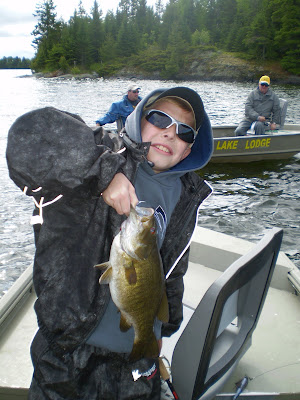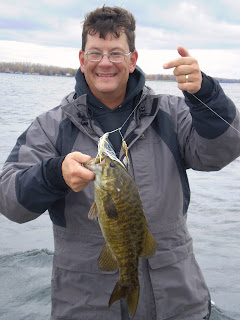
This fish is commonly called a Lion Fish, but is also known as a TURKEY Fish. I figured it was appropriate as a lead-in for a Thanksgiving post.
Well, Thanksgiving has come and gone. It's snowing outside right now in northern Illinois. My late season pond fishing was thwarted this year by ice - we've had thin ice on the ponds for the past week and a half. A few years ago, on the day before Thanksgiving, I caught 6 nice largemouth in the pond across the street with 1/8 oz. Strike King Bitsy Jig and Craws. This year, those jigs wouldn't have made it through the ice. I still have one fishing opportunity this year to look forward to - I'm planning on fishing a day on the Sacramento River Delta a week before Christmas. The plan is to be there when the big stripers come in, but the fish don't always listen. Even if they're scarce, there are always stripers and largemouth willing to bite a swimbait.
I have a lot to be thankful for, even in these trying economic times. I have a job that I love, it's in the Fishing/ Outdoor Industry, a terrific family, I get to watch my 11 year old son grow up, - not bad at all.
My son, Joey, with a nice smallmouth from Shoal Lake , ONT, this past summer
Anyway, I've had a nagging urge to come up with a LIFE LIST of species caught. I just read Ben's list on his blog ( http://www.benfishinglog.blogspot.com/ ) and it motivated me to try to put mine together. A couple of issues arose for me: 1) I don't know that much about species of panfish, so I only put down the ones I know for sure, and 2) one of the things I really like to do is fish off the bridges in the Keys when the winds blow too hard to get out on a boat or wade for bonefish. I fish light, and have caught a myriad of "aquarium fish". Don't know what 90% of them were from a technical standpoint, but they were neat. So - they weren't counted.
The recalling of the list is fun, and now that its been done, I can add to it when I catch something new. Also - I counted 99 species, so 100 will be a milestone. I think 100 is pretty attainable if you fish primarily SW, but I am primarily a FW guy with occasional forays into the brine.
FRESHWATER (58) :Rainbow Trout, Brown Trout, Brook Trout, West Slope Cutthroat, Greenback Cutthroat, Bonneville Cutthroat, Yellowstone Cutthroat, Coastal Cutthroat, Dolly Varden, Grayling, Landlocked Salmon, Atlantic Salmon, King Salmon, Steelhead, Inconnu, Lake Whitefish, Mountain Whitefish, Coho Salmon, Largemouth Bass, Smallmouth Bass, Spotted Bass, Wiper, Bluegill, Redear Sunfish, Brim, Pumpkinseed, Black Crappie, White Crappie, Yellow Perch, White Perch, White Bass, Yellow Bass, Rock Bass, Fallfish, Musky, Northern Pike, Tiger Musky, Chain Pickeral, Burbot, American Eel, American Shad, Hickory Shad, White Sturgeon, Channel Cat, Flathead Cat, Blue Cat, Yellow Bullhead, Brown Bullhead, Walleye, Sauger, Common Carp, Mirror Carp, Sucker, Quillback Carpsucker, Bowfin, Gar, Sheepshead (Freshwater Drum)
SALTWATER (41): Striped Bass, Sea trout, Sea Bass, Sea Robin, Oystercracker, Stingray, Flounder, Tarpon, Bonefish, Grunt, Barracuda, Rainbow Runner, Lane Snapper, Mangrove Snapper, Cero Mackerel, Black Grouper, Redfish, Sheepshead, Snook, Spanish Mackerel, Ladyfish, Bluefish, Pacific Sailfish, Yellowfin Tuna, Wahoo, Mahi Mahi, Roosterfish, Broomtail Grouper, Cubera Snapper, Jack Crevalle, Amberjack, Lemon Shark, Blacktip Shark, Hammerhead Shark, Sand Tiger Shark, Tautog, Bonito, Skipjack Tuna, Ballyhoo, Spiny Dogfish, Pinfish
99 total, at least that I can recall. Chime in - rack your brain to come up with your personal list. It was fun recalling. Especially on a snowy November afternoon.
Happy Thanksgiving!
 Trophy roosterfish - 64", 70 lbs. +
Trophy roosterfish - 64", 70 lbs. +

 My son Joey with a chunky Ontario smallmouth
My son Joey with a chunky Ontario smallmouth


 A classic delta spot - water flows on the tidal changes from the channel to the pond and back
A classic delta spot - water flows on the tidal changes from the channel to the pond and back The Jigging Spoon we finally caught some fish on!
The Jigging Spoon we finally caught some fish on! Len's Carp on a jigging spoon
Len's Carp on a jigging spoon




 Fenwick HMG UL spin road, circa 1985. This is one of the first "good" rods I ever bought, and I still use it as much as nearly any rod I own. I love to fish for panfish, so it is usually along with me on my walks around the local ponds. It's too short (4-1/2'), too light and whippy, and the cork handle is so dirty its hard to see the cork anymore. But - it works. This would be hard - to - impossible to replace, because the rod isn't made the same way it used to be.
Fenwick HMG UL spin road, circa 1985. This is one of the first "good" rods I ever bought, and I still use it as much as nearly any rod I own. I love to fish for panfish, so it is usually along with me on my walks around the local ponds. It's too short (4-1/2'), too light and whippy, and the cork handle is so dirty its hard to see the cork anymore. But - it works. This would be hard - to - impossible to replace, because the rod isn't made the same way it used to be. Weighted bobbers and Cubby Mini-Mites. I found weighted bobbers about 6 years ago, and my panfishing has expanded tremendously because of it. These bobbers let you cast a mile, and the weight renders them close to neutrally buoyant, easily detecting the most subtle strikes. Paired with a Cubby Mini Mite, they create a perfect panfish combo. I don't know what it is about the Mini Mite that makes them work so well, but they just flat-out catch fish. I've tried the knock-offs, and I fish a lot of grubs (see below), but Mini Mites are my go-to baits when UL fishing.
Weighted bobbers and Cubby Mini-Mites. I found weighted bobbers about 6 years ago, and my panfishing has expanded tremendously because of it. These bobbers let you cast a mile, and the weight renders them close to neutrally buoyant, easily detecting the most subtle strikes. Paired with a Cubby Mini Mite, they create a perfect panfish combo. I don't know what it is about the Mini Mite that makes them work so well, but they just flat-out catch fish. I've tried the knock-offs, and I fish a lot of grubs (see below), but Mini Mites are my go-to baits when UL fishing.




 Steven (guide) poling the skiff
Steven (guide) poling the skiff

 8 ½ pound bonefish
8 ½ pound bonefish


.JPG)

.JPG)



.JPG)















 Brook trout from the meadow
Brook trout from the meadow Clear waters of the Big thompson River in the lower canyon
Clear waters of the Big thompson River in the lower canyon